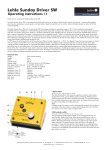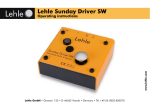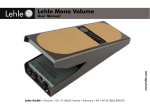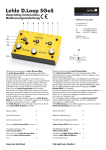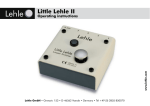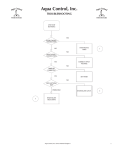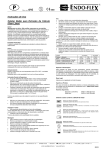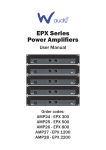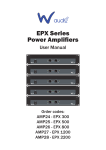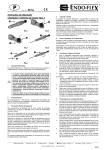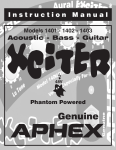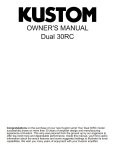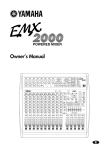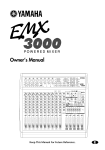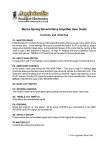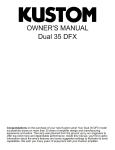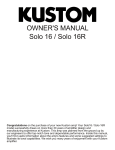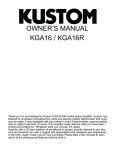Download Lehle Sunday Driver XLR Bedienungsanleitung und - Bax
Transcript
Lehle Sunday Driver XLR Operating instructions Lehle Lehle Gitarrentechnik Thank you for choosing the Lehle Sunday Driver XLR! The Lehle Sunday Driver XLR is a compact-format high-end preamp for all types of electrical and acoustic instruments - a preamp that enables electric guitars and basses, acoustic guitars, and also other stringed instruments (such as violins, cellos and double basses) to unfold all of their musical potential. The XLR variant is equipped with a balanced XLR output and a ground-lift switch. On stage, it can be used as a compact DI box and as a line-driver for long cable distances. In studio use its broad output range of 20 to 100,000 Hz makes it ideal as a recording preamp or as a DI box, whether as a battery-operated stand-alone unit, or integrated into existing setups. The Lehle Sunday Driver XLR, with its high-quality JFET technology, provides two modes, which are selected by a switch with gold-plated contacts. In mode D (= Driver), the input signal is amplified with absolutely no modification. This eliminates the signal losses that long cable routings and/or impedance matching errors with high-impedance signals from passive pick-ups can cause. The signal remains powerful and clear, retaining its dynamics and brilliance. Mode S (= Sunday) multiplies the input impedance by four, bringing out previously inaudible details. As gain increases on the Lehle Sunday Driver XLR, the sound takes on an unmistakable and characteristic warmth. There is no distortion at any stage, and the signal remains clean at all times, even at the maximum gain setting of 15 dB. To exploit the dynamics to the full, the input voltage is rectified from the power supply socket, filtered, stabilized and then doubled to 18V. The Lehle Sunday Driver XLR is totally free of background noise, thanks to its studio-standard signal-to-noise ratio of better than -100 dB. Technical data Weight: Length: Width: Overall height: Voltage range: Max. power battery consumption: Frequency response: Distortion: Impedance, Input D: Impedance, Input S: Impedance, Output: Signal-to-noise ratio: Max. level: Max. gain: 362 g (without battery) 8.8 cm 9.2 cm 4.2 cm 9 - 20 V AC or DC, or 9V PP3 battery 19 mA 20 Hz - 100 kHz (in mode D) 0,001 % at 1kHz, 0 dBU 1 MOhm 4 MOhm 110 Ohm -102 dB at 1kHz, 0 dBU (A-weighted) 5,1 V RMS (approx. 16 dBU) 15 dB 1 Input socket YConnect your instrument to this socket The Lehle Sunday Driver XLR processes signals from electric and acoustic stringed instruments, such as electric guitars and basses, Western guitars, classical guitars and all kinds of stringed instruments. This compact preamp has no trouble matching low signal levels and eliminating sound losses caused by long cables and trebly pick-ups. Note: In battery mode, the battery circuit is automatically activated when a cable is connected to the input socket so always pull the plug when you've finished your session or you want to take a longer break! 6 7 1 2 3 7 Screw Schraube Bottomplate of switch Bodenplatte des Schalters Base-plate Grundplatte 4 5 2 S/D-selector switch YUse this switch to select the sound mode you want This gold-plated-contact switch enables you to change between the two sound modes. Mode D for Driver selects neutral amplification with an input impedance of 1MOhm, identical to a guitar amp´s input stage, efficiently eliminating sound losses caused by long cables and/or effects cascades. The signal remains strong and clear, and retains its dynamics. In mode S for Sunday, the input impedance is multiplied by four, to 4 MOhm, making previously unheard details suddenly audible and imparting an unmistakable and characteristic warmth to the sound when the gain knob is turned up. Washer U-Scheibe Spacer Distanzstück Lehle Gitarrentechnik · Burkhard Georg Lehle · Im Hundsbusch 11 · D-46562 Voerde/ Germany · tel +49.(0)2855.8500-70 · fax -71 [email protected] · www.lehle.com -1- 3 XLR output socket YConnect your target device here For instance, an amplifier with a balanced XLR input, a mixing console, a stage-box or a soundcard. Pin assignment of the XLR socket: 2 1 3 Pin 1: Shield Pin 2: Signal in Phase Pin 3: Signal out of Phase 4 Groundlift switch YWhen it comes to hum noises, engage this switch With this switch you can disconnnect the shield from pin 1 of the XLR socket and signal ground of the Lehle Sunday Driver XLR. 5 External power supply YConnect a power-pack for a voltage of 9 to 20 V here, when needed The Lehle Sunday Driver XLR can be operated optionally with a 9 V PP3 (block) battery or from an external power supply, which should provide not less than 9 and not more than 20 Volts. Polarity is not important here, and both AC and DC sources can be used. The supply voltage is internally rectified, filtered, stabilized and then doubled to 18 V. A suitable connector for the Lehle Sunday Driver's power-supply socket is included in the pack; if desired, this connector can also be soldered to your power-pack mains cable. The cover must be removed to permit installation of a 9V (PP3) block battery. To do this, simply unscrew the four screws holding the cover, and draw the cover and take it off. Note: The Lehle Sunday Driver XLR automatically switches via a gold-plated-contact relay to battery operation if power supply voltage drops below 9 Volt. Please always make sure that the Sunday Driver has a charged battery if you want the extra security of knowing that it will continue to operate trouble-free even if the power supply fails. 6 Gain controller YUse the gain controller to adjust the intensity of the preamp from a slightly refreshed sound level up to a powerful boost The gain control knob consists of black anodized aluminium and is recessed into the housing. It can be easily turned by placing your fingertip in the top depression. Thanks to the recessed design, the setting cannot be inadvertently disturbed on stage or during transportation, which is a great advantage. The Lehle Sunday Driver SW with its JFET-based circuitry performs two functions simultaneously, reducing signal impedance, on the one hand, and boosting the signal, on the other. The Lehle Sunday Driver SW as an impedance converter: When the gain controller is at the left-hand stop (in the 0 or seven o'clock position), it operates purely as an impedance converter. With the knob in this position, the sound is refreshed, in order to equalize sound losses that can occur when long cables or effects cascades are used. The Lehle Sunday Driver as a booster: A buffer starts to amplify the signal when the gain controller is turned in the clockwise direction. Tube amplifiers, preamps and distortion pedals can thus be driven slightly beyond the limit. In S mode the Lehle Sunday Driver SW amplifies less treble with increasing Boost settings to make sure that the resultant overdrive distortion sounds harmonious. The result can range from a pleasant sound, with no shrillness, up to a silky and warm overdrive distortion on tube amplifiers. 7 Base and fixing YYou can use the fixing screws supplied with the Lehle Sunday Driver SW to fix it to a base plate (or to a pedal board, for example) Thanks to its ready-to-go fixing system, the Lehle Sunday Driver SW can be mounted without difficulty on a base plate. To do this, undo the four housing screws and detach the cover. Then fix the device to a base plate using the two screws, the washers and the spacers supplied. Replace the cover and tighten the four housing screws - done! Lehle Gitarrentechnik · Burkhard Georg Lehle · Im Hundsbusch 11 · D-46562 Voerde/ Germany · tel +49.(0)2855.8500-70 · fax -71 [email protected] · www.lehle.com -2- Typical uses The Lehle Sunday Driver XLR universal properties make it equally suitable for live use on stage and in the concert hall aas well as for studio recording sessions. The following few pages show a number of typical applications in which the Lehle Sunday Driver XLR can be a useful addition to your gear! The Lehle Sunday Driver XLR as a preamp for mixer inputs S D 9-20V Lehle Sunday Driver XLR DI Buffer & Booster Due to their input impedance of approx. 10 KOhm, the balanced inputs on mixers are not suitable for level-matched recording of high-impedance signals from magnetic pick-ups (e.g. the single-coil and humbucker pick-ups on guitars and electric basses). The signals from piezo pick-ups, like those used on acoustic instruments, are also too weak for the balanced inputs of a mixer. In a recording situation, the Lehle Sunday Driver XLR is again the ideal tool to turn a high-impedance instrument signal into a low-impedance instrument signal and matching it to the balanced input of a mixer. The Lehle Sunday Driver XLR, with its input impedance of 1 MOhm (or 4 MOhm in S mode) delivers the instrument´s sensitive signal to the mixer totally genuine and complete with all its details. Tip: In S mode and with a gain setting of 11 - 12 o'clock or higher, instruments with piezo pick-ups, which can sometimes sound very harsh and shrill, take on a pleasantly warm and silky tone. The Lehle Sunday Driver XLR as a recording preamp S D 9-20V Lehle Sunday Driver XLR DI Buffer & Booster PCs featuring either integrated or external sound cards, and even Digital Audio Workstations (DAWs), often lack the high-impedance instrument input needed for direct recording from an instrument. Connecting the instrument to the standard balanced input of such devices generally fails, because the instrument's signal level is too low. The result is a significant sound discoloration, due to the incorrect input impedance of the balanced input. The Lehle Sunday Driver XLR can be used to change your instrument's sensitive high-impedance signal into a balanced low-impedance signal and thus compatible with your sound card or DAW, while at all times retaining your instrument's original sound. Tip: If you want to re-amp a signal recorded dry, connect the Lehle P-Split II to your sound card or DAW for the mix, reduce the volume on the sound card or DAW a little, and connect the ISO output of the Lehle P-Split II to an amplifier. Lehle Gitarrentechnik · Burkhard Georg Lehle · Im Hundsbusch 11 · D-46562 Voerde/ Germany · tel +49.(0)2855.8500-70 · fax -71 [email protected] · www.lehle.com -3- The Lehle Sunday Driver XLR as a cable driver The use of long cable runs on stage or in a recording studio involves the danger of significant and audible loss of sound quality. You can eliminate this tone loss by positioning the Lehle Sunday Driver XLR as a cable driver in the signal path directly after your instrument in combination with a Lehle P-Split II directly before the amp. The output of the Lehle Sunday Driver XLR must be connected to the input of the Lehle P-Split II by using a balanced cable. The Lehle P-Split II transforms the balaned signal of the Lehle Sunday Driver XLR into an unbalanced signal, which is identical to that signal coming from the instrument. The signal sustains the full sound quality even at cable runs of 100 meters (approx. 300 ft). 100 m (balanced) ISO S D 9-20V DIR Lehle Lehle P-Split High Impedance Splitter Sunday Driver XLR DI Buffer & Booster Pin assignment of the balanced signal path between Lehle Sunday Driver XLR und Lehle P-Split II 2 1 3 Shield Signal out of Phase Signal in Phase 1/4" TRS jack Shield Ring Tip XLR jack Pin 1 Pin 3 Pin 2 Lehle Gitarrentechnik · Burkhard Georg Lehle · Im Hundsbusch 11 · D-46562 Voerde/ Germany · tel +49.(0)2855.8500-70 · fax -71 [email protected] · www.lehle.com -4-




